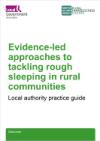Homelessness in rural England is on the rise, meaning too many people face the danger of having no place to call home. Research by the Universities of Kent and Southampton, in partnership with the Rural Homelessness Count coalition found there has been a 24 per cent rise in levels of rough sleeping in rural areas in just one year between 2021 and 2022, while research from CPRE has shown that over the past five years statutory homelessness has risen 40 per cent in rural communities.
Despite the prevailing image of homelessness as occurring in cities, we know that homelessness can occur anywhere. Sparsity, remoteness and other socio-geographical challenges may render homelessness in the countryside less visible, but that does not mean it is not there.
Local authorities across England are working tirelessly to prevent and respond to homelessness, but there has often been a lack of attention on the specific needs and realities of homelessness prevention and relief in rural areas. Research by the Universities of Kent and Southampton, in partnership with the Rural Homelessness Count coalition, has found that rural areas face particular challenges. These include physical isolation, the absence of support services and limited transportation options. Insufficient funding in rural areas often pushes people to urban centres. The shame and stigma associated with homelessness in more affluent or rural areas can be a significant barrier to getting support.
This is amongst the first pieces of work to look at local approaches to rural rough sleeping, and is one step of an ongoing effort by the Local Government Association and Rural Homelessness Counts coalition to map and pool effective practice and ideas across England. This work has looked specifically at rough sleeping, and recognises the important role that data and evidence can play in preventing and relieving rough sleeping in rural communities.
This comes at the same time as new efforts to develop data-led approaches to rough sleeping, such as the partnership between the Department of Levelling Up, Housing and Communities and the Centre for Homelessness Impact, to develop a framework to measure progress towards the vision of ending rough sleeping. This guide can be utilised as part of efforts to adopt data-led approaches across the breadth of England, and ensure that no one has to sleep rough in any part of the country – including rural areas.
Rural homelessness is by far one of the worst things… Nobody knows you’re there, nobody cares you’re there, you are on your own.
Person experiencing homelessness in rural England

